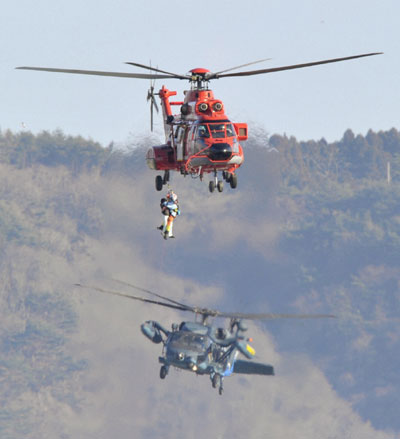Nuclear Meltdown
Japan mounts massive quake rescues
(Xinhua)
Updated: 2011-03-12 22:34
 |
Large Medium Small |
|
 A person who was trapped in a building is rescued by helicopter after a tsunami and earthquake struck in Kesennuma City, Miyagi Prefecture in northeastern Japan March 12, 2011.[Photo/Agencies] |
At least 3,000 people have been rescued following Friday's great earthquake, Prime Minister Naoto Kan said late Saturday at a meeting of the government's anti-disaster countermeasure unit.
"This is the largest earthquake since the Meiji Era (1868-1912), and it is believed that more than 1,000 people have lost their lives," said Chief Cabinet Secretary Yukio Edano at the headquarters of the crisis center set up by the government in Tokyo to coordinate the response to the disaster.
The massive quake triggered 10-meter high tsunami ripping through towns and cities along the northeast coast regions, sweeping away houses, cars and ships.
Latest death toll was reported at around 600, and the total number of people who have died or are unaccounted for is estimated to top 1,700, while about 300 to 400 bodies were found along the waterline in Sendai, a north-eastern city that is worst pummeled in the tragedy, according to Japanese media reports.
The government announced Saturday it will send a further 30,000 members of the Self-Defense Forces, to join the 20,000 already deployed to assist in the rescue and facilitate the urgent need of support at this crucial time, when hundreds of people were thought to be buried under rubble, stranded on rooftops, or unable to reach evacuation areas.
The defense ministry said that 190 aircraft and about 25 vessels have been or are in the process of being deployed.
Defense Minister Toshimi Kitazawa said he expected both senior government officials and SDF will ferry 900 Ground Self-Defense Force (GSDF) personnel and 250 vehicles by US ships, to quake- stricken coastal regions. It also said joint rescue missions will be conducted by Maritime Self-Defense Force and the US 7th Fleet off the Pacific coast.
It was the largest-ever anti-disaster mission ever carried out between the two forces in Japan, the defense ministry said.
GSDF forces arrived Saturday to ensure the safe evacuation of local people living near two stricken nuclear reactors in Fukushima Prefecture that was made malfunctioned by the earthquake. Around 3,000 residents have been safely transferred.
The Japanese government confirmed Saturday afternoon that while an explosion did occur at the Fukushima No. 1 nuclear power plant earlier in the day, the blast did not happen at the location of its No 1 reactor.
Medical teams from 52 hospitals from around the nation have been sent to the quake-hit areas to help treat the injured.
A total of 50 nations and regions have promised to provide with relief support, and offers from over 70 specialist rescue services from around the globe have been received by Japan, with crews from Australia, News Zealand, South Korea being requested to join a 150- member team from the United States making its way to the devastated northeast of the country.
China's International Rescue Team has put its members, equipment, materials and medicines in place and are ready to depart for Japan at any time, director of the China Earthquake Administration Chen Jianmin said.
Local reports said more than 215,000 people were in emergency shelters in eastern and northern Japan.
Rescue and recovery efforts continued as numerous aftershocks were expected for the coming days.
| 分享按钮 |